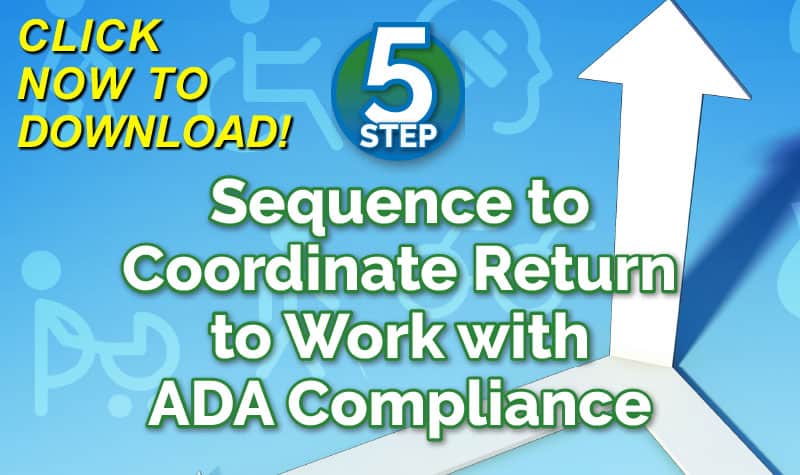
This post is one of a series as a follow up to this webinar:
- ADA – Questions on Temporary and Permanent Restrictions
- ADA – Reasonable Accommodation And Workers Comp Questions Answered
- ADA – Ensure Interactive Process Compliance, And Other Questions Answered
- ADA – What Happens When An Employee Opposes Return To Work?
- ADA – If No Light Duty Is Available, Can The Employer Terminate Employment?
A follow-training on How to Coordinate Return to Work with ADA Compliance initiated additional questions:
- ADA – If light duty cannot be accommodated, should FMLA run concurrently?
- ADA – Do All Work Comp Injuries Fall Under the Americans with Disabilities Act Amendments Act (ADAAA)?
- ADA – Is it against the law not to hire a person with a disability for a physical position?
Click Link to Access Free PDF Download
“5-Step Sequence to Coordinate Return-to-Work with ADA Compliance”
Is a reasonable accommodation having someone else do part of the worker’s job? For example, all of the lifting?
If lifting is an essential function of the job (central to what the person was hired to do), then, generally, no. Reasonable accommodations enable the person to do the essential functions of the job, not eliminate them.
A few clarifications, though:
It’s possible that someone in a certain position is sometimes expected to lift something, but it’s not really what they were hired to do. We call that a “marginal” function. For example, an accountant might occasionally have to lift a heavy box of records above shoulder height to put it on a high shelf in a storage room. Because she’s an accountant, her job really isn’t lifting.
In a case like that, having someone else help with the lifting could be a reasonable accommodation, especially if it’s for the short term. But sometimes it’s possible to accomplish the same job tasks without needing anyone else’s help — and that might be even better. For example, if the person could use a hand truck/trolley to move the records, and they could be stored on a lower shelf, the employer may need to make that reasonable accommodation.
If the job involves rotations or assignments that sometimes require lifting and sometimes do not, assignment to a non-lifting rotation/assignment may be a reasonable accommodation that the employer might have to provide, unless doing so would impose undue hardship.
Can you address how Collective Bargaining Agreements (CBAs) affect the interactive process for accommodation?
This is a complicated topic, and I can’t cover it all here. But two basic points are: (1) the ADA prohibits employers from entering into CBAs that discriminate on the basis of disability, and (2) employers are required to comply with the ADA regardless of whether a CBA exists.
In the reasonable accommodation context, many times it will be possible to provide a reasonable accommodation without violating the terms of a CBA. If an accommodation is required that would violate the terms of a CBA, the employer and union may need to negotiate a variance. If a CBA is raising complicated ADA issues for you, you may wish to consult a private attorney.
Can Ergonomic Worksite Analysis serve as part of an Interactive Process since it engages the employee in identifying alternative methods, tools, and techniques to perform essential functions? The report can serve as a foundation for employees and employer to discuss reasonable accommodations. What are your thoughts?
That sounds like it would be a good idea, as long as the person doing the analysis knows to consider alternatives to the normal way in which job functions are performed. This could include alternatives that someone who specializes in ergonomic analysis is not used to considering, like telework.
Is Reasonable Accommodation “all or nothing”? If an employer can only provide 4 hours a day, 20 hours a week, and such an accommodation is offered, yet turned down by the employee, is that now a situation for separation?
If a reasonable accommodation would enable the person to do the essential functions of the job, and would be consistent with the person’s medical needs (would not cause pain, reinjury, etc.), then the employer can require the individual to do the work with the accommodation. If the individual simply refuses to do work that he or she is perfectly able to do, then he/she could be terminated, just like anyone else who decides not to do their assigned work.
I would be careful about describing reasonable accommodation as “all or nothing” though. If an employer offers someone a reasonable accommodation that turns out not to be effective (for example because the person is still experiencing too much pain), then the employer and employee should go back to the drawing board to determine whether a different solution is possible. Also, the exact accommodation needed could change over time.
I should also point out: allowing someone to do less work (e.g., 4 days instead of 5) for the same amount of pay is not an ADA reasonable accommodation, meaning that the employer could not be legally required provide it. (The employer is perfectly free to provide it, though.*) The employer and employee should explore whether something other than reduced productivity would help.
Also, if an on-the-job accommodation isn’t possible (and if the employee does not have any paid leave available to use at their discretion), the employer might be required to provide extra unpaid leave as a reasonable accommodation instead of termination, if it would allow the person to eventually return to work, and if providing the unpaid leave wouldn’t cause significant difficulty or expense for the employer. If the employee will never be able to return to the original job, then the employer should consider reassignment to another job as a reasonable accommodation, if one is available and the person is qualified. If all of that fails, then the ADA doesn’t prevent termination.
*[Publishers Note: The biggest distinction between an ADA Reasonable Accommodation and a “light duty” workers comp best practice is the expected output of the employee. The ADA requires essential functions of the job to be performed. Light duty typically reduces or modifies essential functions, but is a best practice that promotes faster recovery, lower medical costs, and eliminates indemnity costs. Light duty is generally not required by workers’ compensation law.]
How does the identification of light duty jobs in general factor into ADA’s interpretation of reasonable accommodations?
It’s my impression that “light duty” usually means that the employee is not being required to do his or her regular job. Perhaps an essential function is eliminated, or the person is doing something different altogether. If that’s what you mean by “light duty,” then light duty doesn’t have much to do with the ADA. The ADA can never require an employer to pay people full wages while they are not doing their regular jobs or to keep people employed who are not expected to regain the ability to perform the essential functions of the position for which they were hired (with or without reasonable accommodation), which includes a reasonable timeframe.
The ADA doesn’t prevent employers from assigning people to light duty positions.*
*[Publishers Note: We continue to recommend the use of transitional work assignments during recovery as a best practice. Transitional work can EITHER take the form of a reasonable accommodation or the more traditional “light duty.” The biggest distinction is the expected output of the employee. The ADA requires all essential functions of the job to be performed. Light duty typically reduces or modifies essential functions or productivity expectations. Either form of transitional work promotes faster recovery, lowers medical costs, and eliminates indemnity costs. Light duty is generally not required by workers’ compensation law.]
How about an objective, validated, functional Fit for Duty test that addresses job-specific tasks that the worker will need to show they can do these safely on the job before returning to work? If not able to do all tasks safely, a modified RTW can be coordinated with both employer and worker?
Most existing methods of evaluating fitness for duty / functional ability do not consider reasonable accommodations. However, functional testing can reveal areas of difficulty where a discussion about reasonable accommodation may be required. So, for example, if a person has a disability that affects manual dexterity, a job-specific functional ability test would reveal that she is unable to keyboard well enough to perform her job – when using the keyboard that is now at her workstation. This should kick off a search for an alternative solution – a reasonable accommodation. Possibilities include a different or voice recognition software for example. Another example: if a workplace uses a siren to warn employees workers of danger, someone who is deaf might nevertheless be fit for duty if flashing lights could be installed as a reasonable accommodation (unless installing the lights would impose undue hardship for some reason).
What about mental health issues and issues such as Narcolepsy– when the medical provider gives the employee a blank slate such as tardiness to work and or the possibility of mistakes at work (performance issues related to the disability).
Accepting poor performance, tardiness, reduced productivity, etc. are not reasonable accommodations. An employee could never use the ADA to require the employer to accept poor work. Note, however, that an employer cannot treat an employee with a disability more harshly than other employees who are having the same problems with performance. An employer couldn’t terminate an employee with a disability for tardiness, for example, if an employee without a disability would not be terminated for the same level of tardiness.
An employer could be required to provide a reasonable accommodation that would prevent performance issues, however. For example, it’s possible that a person could ask for permission to arrive an hour late and leave an hour late as a reasonable accommodation, because of the side effects of medication, for example (notice that the overall amount of work is the same). Or the supervisor might be required to provide detailed written instructions for assignments, so that the person doesn’t forget or become confused.
Really, the doctor should not be deciding whether the employee is allowed to arrive late or to make mistakes. The doctor should be describing the mental and physical effects of the medical condition. The employer and employee are the ones who are supposed to figure out how those restrictions should affect work.
Is it really considered reasonable to provide extra paid breaks to associates? Wouldn’t this cause issues with how other associates might be treated?
No, extra paid breaks could not be required if it means less total time spent on work throughout the course of the day. A person could ask for his break to be at a different time than usual, however, or for it to be split up into small chunks, or to work a longer day in order to allow time for more breaks.
Setting aside the issue of reduced productivity, though, from the point of enforcement, it is generally not relevant how coworkers perceive an accommodation. A person who needs a special chair because of a back problem, for example, might be entitled to get it even if coworkers would become jealous.
It is up to the employer to manage the impact of this on the workplace by signaling to all employees that the process is being managed thoughtfully, firmly and fairly, so people get what they legitimately need, not just what they demand. The employer is not allowed to explain that the reason for the special chair is a disability (breach of confidentiality). However, it is appropriate to make sure every employee remains aware of the company’s commitment to upholding the ADA and helping employees who have or develop disabilities to stay at work and keep their jobs.
Let’s say an employee is given sedentary duty work restrictions by a doctor, and the employer allows the employee to work with those restrictions. But after a period of time (a few months), the employer can no longer afford to allow the employee to work sedentary duty. Does the employer still have a duty to provide a reasonable accommodation under the ADA? Is the employer now required to find a sedentary job for the employee in another department if there is no sedentary work in the employee’s current department?
I assume you are thinking of a situation in which the person is not performing his/her usual job. The ADA never requires an employer to keep paying an employee who is not doing the job for which he/her was hired, no matter how long this kind of substitution has already been happening. The ADA couldn’t even require it at the beginning of the situation you describe. That’s not considered an ADA “reasonable accommodation.”
The employer could be required to provide a reasonable accommodation in a situation like that, if there is one that would enable the person to do his or her regular job. (Could the person accomplish what his usual job requires him to accomplish while sedentary, for example, by allowing him to work from home, or allowing him to use a wheelchair, or… ?)
If an on-the-job accommodation isn’t possible (and if the employee does not have any paid leave available for use at his/her discretion), the employer might be required to provide extra unpaid leave as a reasonable accommodation, if it would allow the person to eventually return to work, and if providing the leave wouldn’t cause significant difficulty or expense.
If the employee will never be able to return to the original job, then, yes, the employer might be required to reassign the individual to another job that is consistent with the limitations. But the other job must actually exist and be currently vacant, and the individual must be qualified for it.
[Publishers Note: In transitional duty as a workers comp best practice, it is common for employee to be assigned “light duty” in which essential job functions are modified or eliminated. When that is the case, the light duty assignment should not last longer than 90 days without medical review to determine whether timely recovery of ability to perform all essential functions is realistic. However, during a prolonged transitional work period, the employer needs to follow the ADA requirements for reasonable accommodation and reassignment, including additional unpaid leave. If the company has done so and the employee cannot resume working after the 90 days, the employee can be considered for termination.]
In a reassigned position, does the employee have to qualify for the position or do we have to train them as a result of meeting that accommodation?
For reassignment to be required under the ADA, the person must already be qualified for the position. There is nothing to prohibit the employer from providing the training as a good faith gesture on a case by case basis.
Visit these articles for more information on the ADA and workers compensation:
Further implications of the ADA on managing workers with health issues
ADA Questions on Temporary and Permanent Restrictions
Author:
Aaron Konopasky is a Senior Attorney Advisor in the ADA/GINA Policy Division at the U.S. Equal Employment Opportunity Commission (EEOC) headquarters in Washington, D.C. He assists the Commission in interpreting and applying the statutes it enforces, and participates in drafting regulations, policy guidance, and other publications.
Dr. Konopasky joined EEOC after receiving his J.D. from Stanford Law School. Prior to law school, he received his Ph.D. in philosophy from Princeton University, and served as an adjunct professor of philosophy at Rutgers University, Tulane University, and the University of New Orleans.
Author
Jennifer Christian, MD, MPH, FACOEM is a thought leader and advocate for improving medical outcomes and preventing needless work disability in workers’ compensation and disability benefits systems. She is board-certified in occupational medicine and earned both her medical and public health degrees from the University of Washington in Seattle. She chairs the Work Fitness & Disability Section of the American College of Occupational & Environmental Medicine (ACOEM). While practicing medicine in Alaska, she was chosen as Physician of the Year.
She is President of Webility Corporation, a management consulting and training company. Most recently, she developed Webility’s newest offering – the non-medical Maze-Masters program which provides educational and life coaching services directly to individuals who have gotten “lost in the system” to help them get their lives back on track.
Editor:
Michael B. Stack, CPA, Principal, Amaxx Risk Solutions, Inc. He is an expert in employer communication systems and helps employers reduce their workers comp costs by 20% to 50%. He resides in the Boston area and works as a Qualified Loss Management Program provider working with high experience modification factor companies in the Massachusetts State Risk Pool. He is co-author of the #1 selling book on cost containment, Your Ultimate Guide To Mastering Workers Comp Costs www.reduceyourworkerscomp.com. Contact: mstack@reduceyourworkerscomp.com.










Thank you, I appreciate the feedback. – Michael Stack
Thanks for a marvelous posting! I definitely enjoyed reading it,
you’re a great author. I will remember to bookmark your blog
and will often come back someday. I want to encourage you to ultimately continue your great job,
have a nice afternoon!